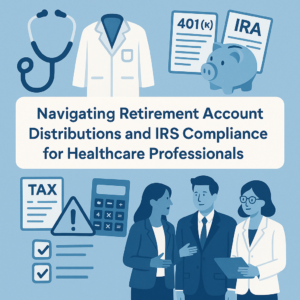Advanced Roth Conversion Strategies for Healthcare Professionals: Maximizing Your Retirement Savings
As a dedicated healthcare professional—be it a physician, dentist, pharmacist, physical therapist, or psychologist—you’ve invested years in your education and career. With demanding schedules and the responsibility of patient care, it’s easy to overlook the complexities of retirement planning. However, implementing advanced tax strategies now can significantly enhance your financial well-being in the future.
One powerful tool at your disposal is the Roth conversion. This strategy involves converting funds from a traditional IRA to a Roth IRA, allowing for tax-free growth and withdrawals in retirement. But is this the right move for you? In this comprehensive guide, we’ll delve into advanced Roth conversion strategies tailored specifically for healthcare professionals, helping you navigate the intricacies of tax optimization and secure a financially sound retirement.
Understanding Roth Conversions
What Is a Roth Conversion?
A Roth conversion is the process of transferring funds from a traditional IRA or 401(k) into a Roth IRA. Unlike traditional retirement accounts, contributions to a Roth IRA are made with after-tax dollars. This means that while you pay taxes on the amount converted today, qualified withdrawals during retirement are tax-free.
Benefits of Roth Conversions
- Tax-Free Growth: Your investments grow tax-free, maximizing your retirement savings.
- No Required Minimum Distributions (RMDs): Roth IRAs are not subject to RMDs at age 73, allowing your assets to continue growing.
- Tax Diversification: Having both tax-deferred and tax-free accounts provides flexibility in managing your taxable income during retirement.
Why Roth Conversions Matter to Healthcare Professionals
High-Income Earners and Tax Implications
Many healthcare professionals are high-income earners, placing them in higher tax brackets. This can result in significant tax liabilities both now and in retirement. By strategically utilizing Roth conversions, you can manage and potentially reduce your lifetime tax burden.
For example, converting during years when your income is lower—such as early in your career or during a sabbatical—can be advantageous. You’ll pay taxes on the converted amount at a lower rate, and enjoy tax-free growth moving forward.
Unique Financial Challenges Faced by Healthcare Workers
Healthcare professionals often face unique financial challenges, including:
- Student Loan Debt: Substantial education expenses can delay retirement savings.
- Late Career Start: Extended schooling means fewer years contributing to retirement accounts.
- High Stress and Burnout: May lead to early retirement, requiring more extensive retirement funds.
Considering these factors, it’s crucial to maximize the efficiency of your retirement savings. Advanced Roth conversion strategies can play a pivotal role in achieving this goal.
Advanced Roth Conversion Strategies
Strategically Filling Up Tax Brackets
One method to optimize your tax liabilities is by filling up lower tax brackets. This involves converting just enough each year to reach the top of your current tax bracket without spilling into a higher one. For instance, if you’re in the 24% bracket, you might convert an amount that keeps you just below the 32% threshold.
This strategy takes advantage of the progressive tax system, minimizing the taxes owed on the converted amount. Over time, this can lead to substantial tax savings, especially if you expect to be in a higher tax bracket during retirement.
Conversion-Cost Averaging
Conversion-cost averaging involves spreading your Roth conversions over multiple years. Similar to dollar-cost averaging in investments, this approach mitigates the risk of market volatility impacting your converted assets.
By converting amounts periodically, you can:
- Benefit from market downturns by converting more shares when values are lower.
- Manage your tax bracket by controlling the amount converted each year.
- Take advantage of fluctuating income levels, converting more in lower-income years.
The Barbell Approach
The barbell approach combines early and late-year conversions. You initiate a conversion early in the year to maximize potential tax-free growth. Then, towards the end of the year, you assess your financial situation and perform additional conversions if appropriate.
This strategy allows you to:
- Capture growth in the Roth IRA throughout the year.
- Adjust for unexpected income or deductions that affect your tax bracket.
- Optimize the total amount converted based on actual earnings and tax liabilities.
When Roth Conversions Might Not Be Beneficial
Anticipated Lower Retirement Tax Brackets
If you expect to be in a lower tax bracket during retirement—perhaps due to decreased income or changes in tax laws—a Roth conversion might not be advantageous. In this case, paying taxes now at a higher rate doesn’t provide a benefit over deferring taxes until retirement.
Significant Retirement Purchases
Planning major expenses in retirement, such as purchasing a vacation home, can impact your decision. Drawing large sums from a traditional IRA for these purchases could push you into a higher tax bracket. A partial Roth conversion strategy might help spread out the tax liability, but this requires careful planning.
Impact on Adjusted Gross Income (AGI)
Increasing your AGI through Roth conversions can have unintended consequences, such as:
- Triggering Income-Related Monthly Adjustment Amount (IRMAA) surcharges for Medicare.
- Reducing eligibility for certain deductions or credits.
- Affecting taxation of Social Security benefits.
It’s essential to evaluate how a Roth conversion will impact your overall financial picture.
Balancing Immediate Taxation vs. Future Benefits
Deciding whether to pay taxes now through a Roth conversion or later during retirement is a complex choice. It involves balancing mathematical analysis with personal preferences and expectations about future tax rates.
Some considerations include:
- Future Tax Legislation: Anticipating changes in tax laws can be speculative.
- Personal Income Projections: Estimating your income and expenses in retirement.
- Legacy Goals: Planning for estate taxes and inheritances.
Engaging in a personalized financial planning process with a professional can help align your strategy with your goals.
Working with Financial Advisors
Collaborative Approach
Effective retirement planning often requires collaboration between you, your financial advisor, and your tax preparer. This team can help you:
- Analyze the mathematical implications of a Roth conversion.
- Understand the tax consequences and benefits.
- Avoid unexpected tax liabilities and penalties.
Open communication ensures that all parties are informed and working towards your best interests.
Avoiding Tax Surprises
Unexpected tax bills can be stressful. By proactively planning and executing Roth conversions with professional guidance, you can minimize the risk of surprises come tax season. Regular reviews of your financial situation allow for adjustments as needed.
Conclusion
For healthcare professionals like you, understanding and implementing advanced Roth conversion strategies can significantly impact your retirement savings. By maximizing tax efficiencies now, you set the stage for a more secure and financially flexible retirement.
Consider working with a financial advisor knowledgeable about the unique challenges and opportunities you face as a healthcare worker. Together, you can develop a tailored plan that aligns with your career, financial goals, and personal values.
Remember, the decisions you make today can profoundly influence your financial well-being tomorrow. Take the time to explore these strategies and invest in your future.
About Us
We specialize in providing personalized financial planning services to healthcare professionals, including physicians, dentists, pharmacists, physical therapists, and psychologists. Our goal is to help you navigate the complexities of tax optimization and retirement planning, so you can focus on what you do best—caring for others.
Contact us today to schedule a consultation and take the first step towards a more secure financial future.







